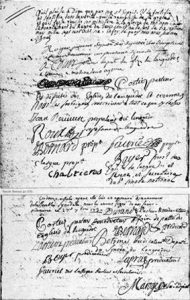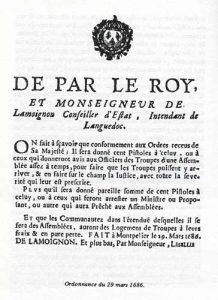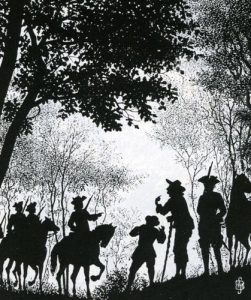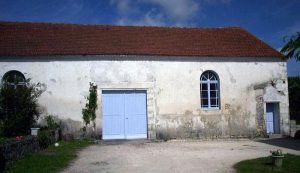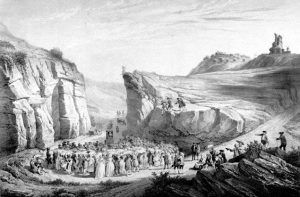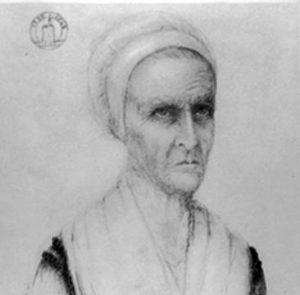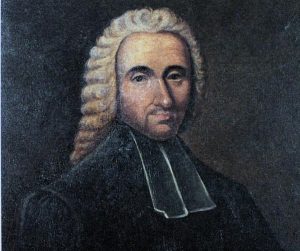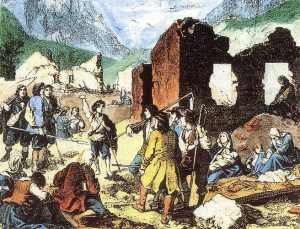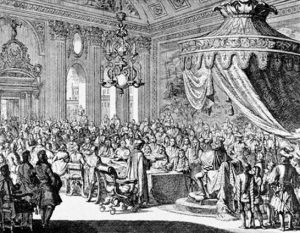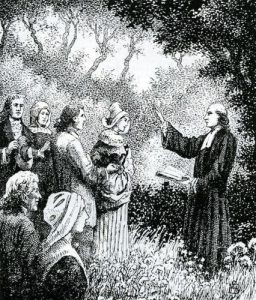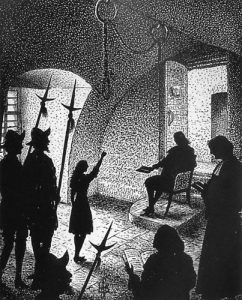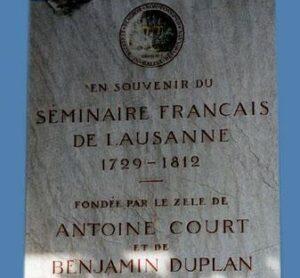The lay preachers and prophets
Following the revocation of the Edict of Nantes, pastors had the choice of exile or renouncing their beliefs. The majority left France and ministered in Protestant countries where they were welcomed (Refuge countries). In France, the laity took over the preaching and distributed the sacraments at secret night-time meetings, held in isolated places. These were the “lay preachers”. Hunted like subversives, many were arrested and executed and others were forced to hide abroad. One of the most famous lay preachers was Claude Brousson.
From 1688 in Dauphiné, then from 1700 in the Cevennes and Bas Languedoc, men, women and even children began prophesying, calling for conversion and a return to the Reformed religion. They gathered around them an ever increasing following.
The first pastors
From 1715, the young lay preacher, Antoine Court (1695-1760) tried to reorganise the Reformed Church by silencing the prophets and re-establishing order. He wanted to create a better trained body of ministers to teach the people and run the meetings, always in secret and known as “Church of the Desert meetings”. These ministers had to be reviewed by a synod and consecrated.
So the lay preacher Pierre Corteiz (1683-1767), friend and assistant of Antoine Court, was sent by him to be consecrated in Zurich. On his return, Antoine Court himself wanted to go to Zurich, but the regional synod refused and decided that Pierre Cortez should preside at the consecration of Antoine Court during a synod (21st November 1718).
The third pastor, Jacques Roger (1665-1745) had a very different story. He left France very young, lived in Switzerland and Germany where he studied theology, was consecrated pastor and exercised his ministry. On the death of Louis XIV in 1715 he left his job and returned to France, where he preached, despite the danger. He stuck to the young Antoine Court’s ideas and exercised his “underground” ministry in Dauphiné for 30 years.
The "Heroic" period (1715-1760)
This period was dominated by the pastor Antoine Court. Even when he had moved to Lausanne, he was still the benchmark for the “Church of the Desert”. He later returned to France for the national synod of 1744. The Languedoc Church called on him to resolve a disagreement about a pastor who refused to obey a synod decision, and which divided both the faithful and pastors. Court went to Basses Cevennes, found a solution and obtained a general reconciliation. As thanks, the synod appointed him “Deputy General“, that is representative for the “underground” church in neighbouring Protestant countries. This job involved asking for grants for the persecuted church and students at the Lausanne Seminary.
Despite the risks until 1762 (death penalty for pastors arrested), vocations to the ministry were as strong as ever.
- In 1718 the “Church of the Desert” had three pastors ;
- In 1730 there were 12 pastors for 120 churches ;
- In 1744 there were 28 pastors for 300 churches ;
- In 1756 there were 48 pastors and18 ordinands.
Pastors had an itinerant ministry. Continually hunted, they had to hide and synods required the elders to find them safe places to do this. Gradually, as the number of pastors grew, they became attached to a particular region. From the outset some were married, like Cortez and Court, but their wives were harassed (by the authorities) and had to take refuge in Geneva.
The martyrs
The succession of edicts from Louis XIV, upheld by Louis XV in his Declaration of May 1724, set the death penalty for pastors or preachers who held banned meetings. How it was applied depended on the time and area. Waves of persecution followed periods of relative calm.
Amongst the pastors and ordinands arrested and executed the most famous was Pierre Durand (1700-1732), brother of Marie Durand, who was condemned to hang in 1732. He was at the synod of Montèzes in 1715.
In 1745 several pastors were executed. Two of these ministered in Dauphiné : the young Louis Ranc and 80 year old Jacques Roger, executed after thirty years in the “underground” ministry.
Feelings ran high in Vivarais after the hanging of the 26 year old pastor Mathieu Marial, known as Désubas, as he was much liked
In 1762 the last pastor was executed in Toulouse : François Rochette.
Towards tolerance (1760-1789)
From 1760 a period of relative calm saw the number of pastors grow rapidly. In 1763 the Church had 62 pastors and 35 ordinands ; in 1783 there were 150 pastors and 30 ordinands.
The important person during this period was pastor Paul Rabaut (1718-1794), who brought together the many groups meeting in Languedoc and who had contacts with the provincial authorities. Meetings were increasingly held openly and gradually dignitaries joined them.
In Saintonge, from 1755, pastor Louis Gibert (1722-1773) built “Houses of Prayer” in which to hold services. These were basic buildings, a kind of barn, which gave shelter from the rain and wind allowing a service to take place every Sunday. Louis Gibert managed to convince the provincial governor, the Marechal of Sennecterre, of the legitimacy of these “Houses of Prayer” which better allowed the authorities to keep tabs on Protestant meetings.
After 1760 many pastors lived, publicly and openly, in their own houses, with their wife and children.
Training of pastors
Candidates for the ministry, or ordinands, were first and foremost trained on the ground, following and learning from practicing ministers, and through banned books. In 1725 Antoine Court founded an organisation in Lausanne to improve training for future pastors of the “Church of the Desert”, known as the Lausanne Seminary. Professors at the Lausanne Academy provided a condensed training, initially over one year and then two years, that was tailored for young people who had not had much formal schooling.
Financing of grants for the students at Lausanne was from collections taken in Refuge countries by Benjamin Duplan, elected Deputy General for Protestant countries by the national synod of 1727, and then, from 1744, by Antoine Court.
From 1726 to 1763 154 students attended the Lausanne Seminary which played an important role in training pastors for the “Church of the Desert”.

